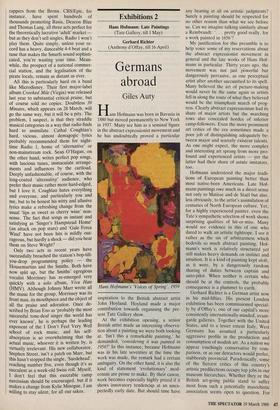Exhibitions 2
Gerhard Richter (Anthony d'Offay, till 16 April)
Germans abroad
Giles Auty
Hans Hofmann was born in Bavaria in 1880 but moved permanently to New York in 1937. Many see him as a seminal figure in the abstract expressionist movement and he has undoubtedly proved a particular Hans Hofmann's 'Voices of Spring', 1959 inspiration to the British abstract artist John Hoyland. Hoyland made a major contribution towards organising the pre- sent Tate Gallery show.
At the exhibition opening, a senior British artist made an interesting observa- tion about a painting we were both looking at. `Isn't this a remarkable painting,' he demanded, 'considering it was painted in 1956?' In this instance, because Hofmann was in his late seventies at the time the work was made, the remark had a certain ambiguity. On the other hand, it is also the kind of statement `evolutionary' mod- ernists are prone to make. By their canon, work becomes especially highly prized if it shows innovatory tendencies at an unex- pectedly early date. But should time have any bearing at all on artistic judgments? Surely a painting should be respected for no other reason than what we see before us. Can we imagine talking similarly about a Rembrandt: '. . . pretty good really, for a work painted in 1656'?
My justification for this preamble is to help voice some of my reservations about the abstract expressionist movement in general and the late works of Hans Hof- mann in particular. Thirty years ago, the movement was not just pbwerful but dangerously pervasive, as one perceptual artist after another succumbed to its spell.
Many believed the art of picture-making would never be the same again as artists fell in along the route of what they believed would be the triumphant march of prog- ress. Clearly abstract expressionism had its share of major artists but the marching rows also concealed hordes of inferior camp-followers. Even the more prominent art critics of the era sometimes made a poor job of distinguishing adequately be- tween major and scarcely existent talents.
As one might expect, the more complex and interesting art sprang from more pro- found and experienced artists — yet the latter had their share of astute imitators, too.
Hofmann understood the major tradi- tions of European painting better than most native-born Americans. Late Hof- mann paintings owe much in a direct sense not only to Matisse and de Stael but also, less obviously, to the artist's assimilation of centuries of North European culture. Yet, for a highly experienced painter, even the Tate's sympathetic selection of work shows surprising qualities of hit-or-miss. Many would see evidence in this of one who dared to walk an artistic tightrope. I see it rather as the sin of arbitrariness which bedevils so much abstract painting. Hof- mann's work is relatively structured yet still makes heavy demands on instinct and intuition. It is a kind of painting kept aloft, as it were, by a dangerously random sharing of duties between captain and auto-pilot. When neither is certain who should be at the controls, the probable consequence is a plummet to earth.
Gerhard Richter is a German artist now in his mid-fifties. His present London exhibition has been commissioned special- ly by d'Offay's, one of our capital's more consistently internationally-minded, avant- garde galleries. Together with the United States, and to a lesser extent Italy, West Germany has assumed a particularly aggressive profile in the production and consumption of modish art. As a nation we appear touchingly conservative by com- parison, or as our detractors would prefer, stubbornly provincial. Paradoxically, some of the fiercest critics of this country's artistic predilections occupy top jobs in our museum hierarchies. Whether they or the British art-going public stand to suffer most from such a potentially masochistic association seems open to question. For
my part I would rather see us proud, not humble, about our artistic individuality, not least because what others look on as international style often requires little more than an ability to plagiarise and imitate.
In spite of the gallery's glowing explana- tions in the catalogue, Richter strikes me as an artist who has thought himself into a corner. Given the currency of art debate in Germany, I am not surprised. His exhibi- tion consists of a series of medium-sized paintings imitating the effect of snapshots of arbitrary-seeming snippets of country- side, plus a series of large, unstructured abstract works. The artist seems to take no interest in the composition of the former but then Nature, we learn from the cata- logue, strikes this world-weary man as essentially baleful and imbecile. Luckily he feels able to tackle his larger works with a touch more enthusiasm. 'Rather than "de- materialise" in the mode of early 20th- century abstraction, Richter has set himself the task of bringing into vivid focus that which we do not yet know.' So avers the faithful catalogue, but such a formidable programme must strike many as ambitious, even for a former pupil of Joseph Beuys.
Richter's lafge, brightly hued canvases, when working in Mark II mode, are produced ingeniously by skidding layers of paint over previously placed colours and grounds, relying heavily on accident for their happier effects. Though more significant-seeming, superficially, than the photo-based landscapes, these paintings are informed, nevertheless, by a similar hollowness and lack of conviction. The happy accident in art tends to remind me of the withering rejoinder made by my dou- bles partner to an opponent who profited from a series of lucky mishits: 'Congratula- tions — but it will never replace tennis.'

























































 Previous page
Previous page